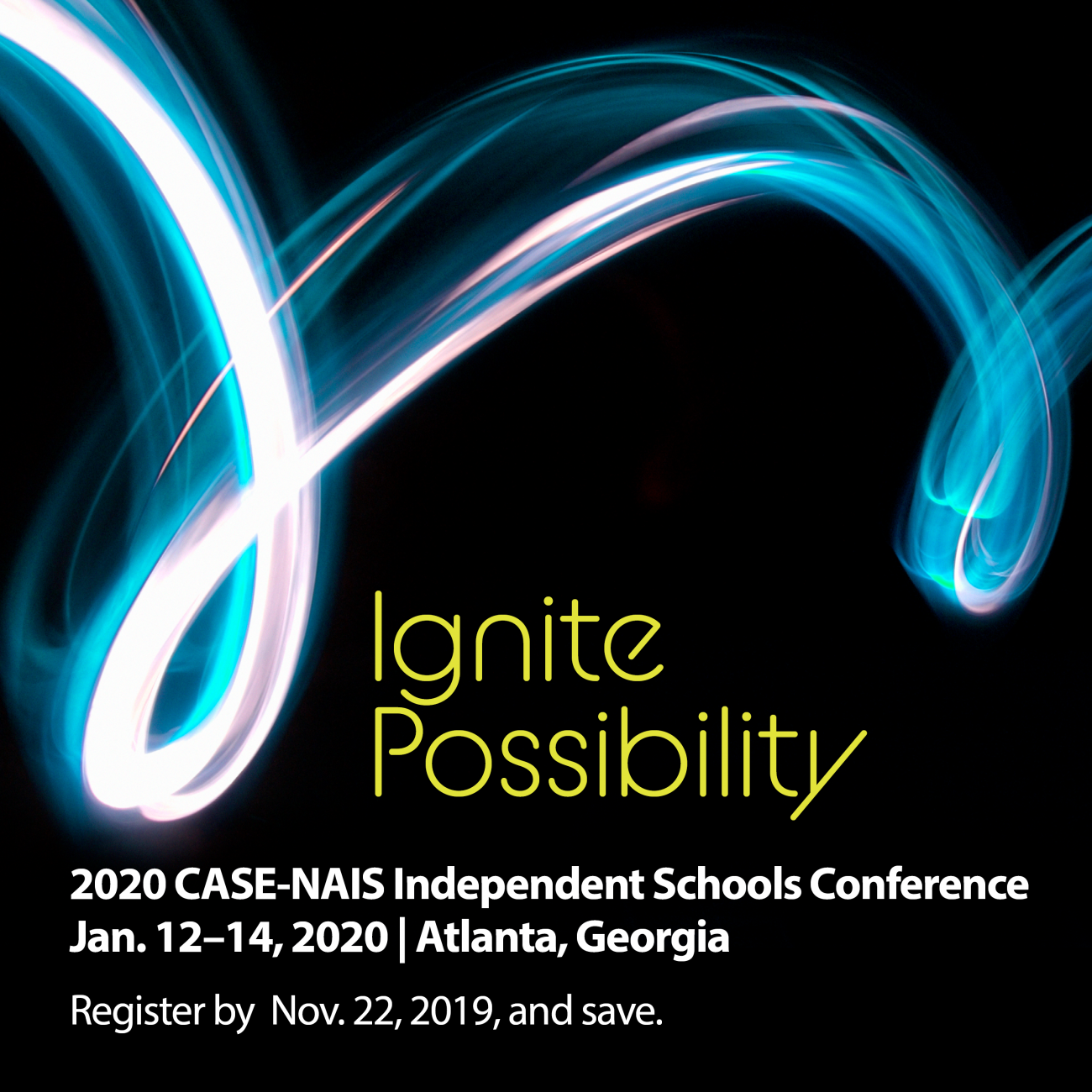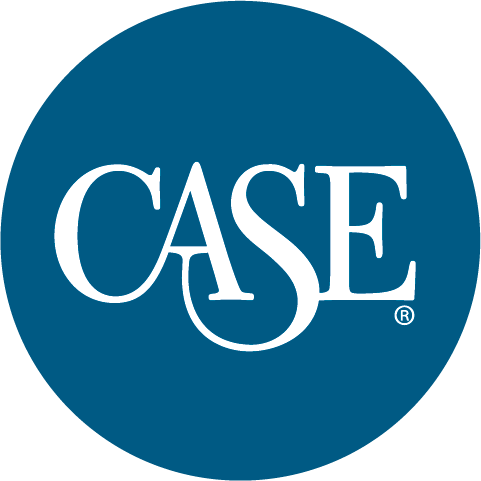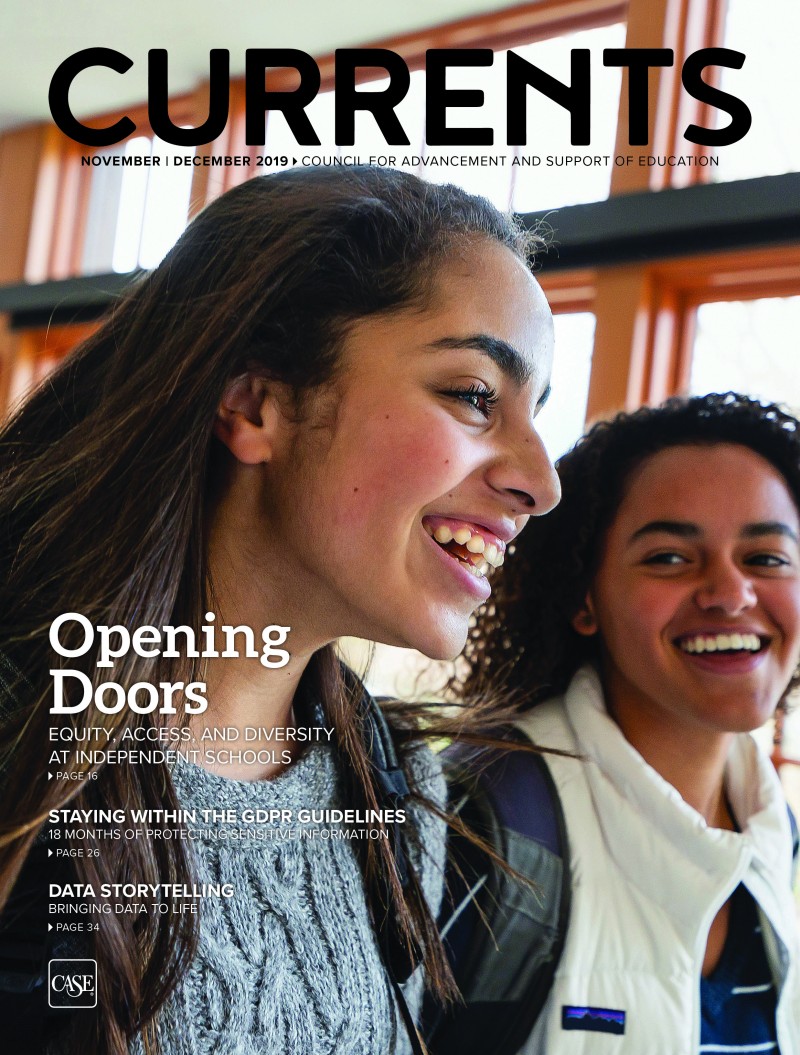
See how the Independent Schools are reducing financial barriers and promotion DEIB

Fire up some fresh ideas in Atlanta this January at the must-attend, annual event for independent schools and advancement professionals. Learn More
Learning about diversity begins early at Laurel School in Shaker Heights, Ohio, U.S. Storytime for 3-year-olds includes picture books such as Shades of People, with vibrant photos of a panoply of children, and Hats of Faith, featuring various head coverings. By middle school, students can join a variety of groups that explore identity, from the Asian Culture Club to the Black Student Union to Linked@Laurel, an affinity group for students of color in which students and teachers explore their experiences in and out of the classroom.
For Lauren Calig, the school’s director of multicultural education, increasing and supporting diversity at independent schools must be thoughtful and purposeful from day one.
“A very high percentage of independent schools were founded by white, Christian men. This is the tradition these schools are steeped in. Now our clientele and students look very different from that, and it is our job to ensure we can support them,” she says. Laurel has 620 girls in its K-12 program, as well as a coed preschool.
Despite schools working to create a culture of inclusion, the number of students of color at independent schools differs markedly from the number at public schools. To help close that gap, independent schools are not just recruiting more students from various backgrounds but also finding ways to help them pay tuition and support them while on campus.
Increasing diversity and integrating a curriculum that includes learning from a variety of viewpoints has benefits for all students, educators say, including improving their critical thinking, problem solving, and communication skills. When students have a better understanding of differing cultures, they’re more prepared for an increasingly global economy and are more confident and empathetic outside of school.

STARTING EARLY: A priority for The Oaks Academy in Indianapolis is making classrooms diverse racially and socioeconomically beginning in pre-K.
Making Diversity Intentional
Figures from the National Center for Education Statistics paint a picture of the contrast in enrollment between independent and public schools. While about 67% of U.S. independent school students were white in the 2017-18 school year, 48% of public school students were white. Similarly, independent school enrollment was 9% black and 11% Hispanic, while at public schools 15% of students were black and 27% Hispanic.
To reduce these disparities, schools must first rethink their approaches to recruit students. Some are expanding their marketing outreach beyond their traditional audiences by attending community fairs and events in new neighborhoods. Some are reaching out to religious communities.
For example, The Oaks Academy in Indianapolis purposefully tries to ensure its three inner-city campuses have a range of family incomes and a balance of students that’s approximately 40% black; 40% white; and 20% Asian, Hispanic, or multiracial. The Oaks, which has 940 pre-K through eighth-grade students and calls itself a “Christ-centered” school, opened in 1998 in an area of the city that saw increasing crime and escalating white flight to the suburbs. Chief Advancement Officer Nathan Hand says The Oaks has been credited with helping revitalize the neighborhood surrounding its first school.
He points out that this intentional recruiting of a diversity of children means that the son of a business executive might be best friends with a child who is homeless. “It’s our everyday, but I think it’s rare and it’s awesome,” he says.
Shanelle Henry, director of equity and inclusion at Greens Farms Academy in Westport, Connecticut, U.S., says, “What’s top of mind is we’re not sitting back waiting for people to come to us. We’re asking, ‘How are we reaching out to communities of color to host recruitment events or partnering with organizations with networks in various communities?’”
Henry, who is also vice chair of the Connecticut Association of Independent Schools Commission on Diversity, advocates marketing to disparate populations using social media and ensuring a school’s website includes photos that speak to a diversity of possible applicants, as well as an easy-to-find page devoted to diversity and inclusion programs at
the school.
There are challenges that can be hard to navigate, though.
“In some cases, it can seem as if we’re asking a person of color to be a martyr at a predominantly white school where there are few students of color. It’s a risk some folks are hesitant to take,” Henry says. She also points to the fact that some schools could be hindered by their location, which may be in a primarily white community.
“Geography can work against you,” she says, as a long commute can cause potential students to cross the school off their application list. (See sidebar for a look at two schools that have created additional urban campuses to help increase access and diversity.)

WELCOMING INDIGENOUS STUDENTS: Ten percent of boarding students at Brisbane Grammar School in Australia are indigenous. All students take part in a program in which traditional Aboriginal dances are shared.
Reducing Financial Barriers
Another stumbling block can be cost. Most independent schools have robust financial aid programs to help reduce tuition for middle- and lower-income families. National Association of Independent Schools member schools offered 25% of their students financial aid in 2018-19, with a median grant of US$17,727 per student.
The problem, says Calig, “is many people dismiss independent schools as too expensive and don’t even consider them.” Laurel School now discusses its need-based aid up front. The school offers $2.3 million annually, which pays up to 95% of tuition.
Seattle’s Lakeside School, which has 850 middle and high school students, offers need-based financial assistance to one-third of its students. The aid extends beyond tuition and covers other school-related costs such as food, books, transportation, a laptop computer, and field trips.
The Oaks Academy purposely keeps tuition low to ensure access across socioeconomic lines. This year, it ranges from $11,445 for first grade to $12,725 for eighth grade. The school benefits from Indiana’s generous tax credits, where for every dollar contributed to a school, donors get 50% back as a tax credit, as well as state vouchers that pay partial tuition at private schools for low-income students.
Another school that offers lower tuition is Templeton Academy, which opened its first school in 2015 on Capitol Hill in Washington, D.C. This fall it opened the doors to another school in Nashville, Tennessee, U.S. At $15,500, the tuition is about half that at many Washington independent schools. Some students pay far less than that.
“We said, ‘Let’s build a school truly socio- and income-diverse by design, with one-third lower, one-third middle, and one-third higher income,” says Temp Keller, founder of the schools.
Templeton Academy keeps tuition low by not having a fancy campus or large footprint. And some of the teachers are hired as adjuncts, who are experts in their fields but may want to teach only one class rather than a full load. There is intensive fundraising for financial aid for those who can’t afford tuition, but Keller notes that it’s a lot easier to raise enough money to fund Templeton Academy’s tuition because the school has far less to raise than do independent schools with much higher price tags.
Brisbane Grammar School in Australia also grapples with how to ensure a cross section of students from throughout the country can attend. The boarding and day school for boys in grades 5 to 12 has 1,700 students. Since its founding 150 years ago, the school has offered scholarships, or “bursaries,” to make the school more affordable to a variety of students. Today, the school’s Campaign 2020 is working to raise AUS$20 million (U.S.$13.5 million) by 2020 for its scholarship fund, with an emphasis on indigenous students, who make up 10% of the school’s boarding students. Raising funds to help foster diversity is not common in Australia, says Headmaster Anthony Micallef.
“Brisbane Grammar School has made a commitment to improve the educational outcomes of Aboriginal and Torres Strait Islander people. We aim to contribute to closing the social, economic, and health gap between First Australian peoples and the broader Australian community and aspire to build a better future,” he says.

REACHING OUT: Connecticut’s Greens Farms Academy puts an emphasis on recruiting a diversity of both students and teachers.
Supporting Students in the Classroom and Beyond
Intentionally recruiting students of color and multicultural faculty are “two sides of the same coin,” says Gina Parker Collins, who founded the organization RIISE (Resources in Independent School Education) a decade ago to bridge the gaps between families of color and the culture of independent schools. Both are integral to students’ success far beyond high school graduation, she notes.
According to research led by Johns Hopkins University and American University last year, having one black teacher in elementary school not only makes children more likely to graduate from high school; it also means they’re significantly more likely to enroll in college. Black students who had just one black teacher by third grade were 13% more likely to enroll in college—and those who had two were 32% more likely. Earlier research by the same team showed that having at least one black teacher in elementary school reduced the probability of dropping out by 29% for low-income black students.
“You want your kids to feel reflected in the faces and spaces they are learning in,” says Philip McAdoo, founder of Atlanta-based Diversity and Inclusion Consulting and former director of equity, justice, and community at Sidwell Friends School in Washington, D.C.
Learning in an inclusive environment must start young, according to McAdoo and other educators. Students of color want to see others like them, but also, their worlds go far beyond their school walls, where they must get along with a variety of people.
Henry is a proponent of teaching about race and diversity from the start. Before she began her career in independent schools, Henry spent a number of years working on equity and inclusion issues in higher education.
“The whole time I was working in higher education with young adults, my number-one question was, ‘How would these students be different if they started having conversations about race and equity before they came to college?’ I noticed their lack of ability, awareness, and comfort from not having the tools to have conversations [about race],” she says. “I realized we had to backtrack 12 years to see what’s missing in the curriculum so we’re not starting at ground zero.”
Just as Laurel School reaches out to market itself to a diversity of potential students at community and religious events, it also intentionally works to recruit a variety of teachers. Last February, Laurel helped start a diversity hiring fair in partnership with other independent schools as well as public schools. The school also tries to identify at least one diverse candidate for each open position and has begun having a larger diversity of staff review résumés to avoid potential unconscious bias.
“Hiring a diverse faculty is a priority. We know that a diverse adult community brings a variety of perspectives to the table and provides students with role models who represent a broad range of backgrounds and experiences,” says Lakeside School Communications Director Amanda Darling. In February the school will augment its diversity hiring practices by hosting its first diversity career fair in collaboration with 18 other schools.
Henry recommends spending time outlining what has and hasn’t worked to increase diversity among faculty and looking for new hiring strategies. The school started affinity groups for faculty this year, stemming from conversations with teachers on ways to help them feel supported and included in all facets of the school, she says.
Parker Collins points out some additional difficulties in hiring diverse faculty that she hopes schools will find a way to address: Often teachers find they can earn more at public schools, and they feel they can make more of a difference in poorer, low-performing schools. “There’s a need to better communicate the benefits of having faculty of color,” she says.
Another component of helping a diversity of students feel included in a school is the curriculum.
“What’s really key is for students to pick up a book by Toni Morrison or another author of color and feel like they’re validated. Hearing their stories lifts them up and lifts up the school,” says McAdoo.
In addition, independent schools often have more latitude than public ones to take students out of the classroom for learning experiences, he says. McAdoo has taken several groups of students to South Africa to learn about apartheid.
Other schools also weave diversity issues throughout their curriculum and in extracurricular activities. For example, Kingswood Oxford School, which has 500 students in its middle and upper schools in West Hartford, Connecticut, U.S., sponsors an annual full-day assembly in which students learn about recognizing bias, confronting racism, and understanding the benefits of diversity. To present the assembly, student leaders and faculty train with the Anti-Defamation League’s A World of Difference Institute. The school also participates in a consortium of 10 local independent schools that hosts diversity-related programs and events.
In Ohio, Laurel School’s Diversity Fellows are juniors and seniors who are selected through an application process and trained on facilitating and leading discussions and programs on diversity, including the annual Martin Luther King Jr. Day of Service. Ninth-grade students at Greens Farms Academy take a required seven-week seminar called Teaching Tolerance, and middle school students can join the Spectrum Club, a student-led group that discusses identity and fostering inclusion. Conversations explore race, culture, and gender.
Whether it’s stepping in to de-escalate a racial incident or deciding whether a school is the right fit, parents also have a critical role to play. Parker Collins, whose two sons attend independent schools, advises schools to offer affinity groups for families of color. She recommends that the group be an autonomous body like the PTA rather than run by the school’s administration.
“Schools that are doing it right are willing to look at themselves critically,” she says. “It’s not what happens if there is an incident involving race, but how you respond to it. Being very transparent with families is key. You need to be saying you won’t always get it right, but you’re going to work toward it."

NEW HORIZONS: Seattle’s Lakeside School and The Downtown School place value on learning outside the classroom, whether it’s a field trip to the nation’s capital or the nearby Pacific Science Center.
Innovating for Access
Some independent schools are thinking outside the box to find ways to diversify their student bodies, from building scaled-down urban campuses to finding jobs for students that help pay tuition. Here’s a glimpse at a few new ideas:
The Cristo Rey Network includes 37 urban college-prep high schools in 24 states. Many students are below grade level academically when they begin, and most are from low-income families. Across the schools, 63% of students are Latino, and 30% are black. While the schools are Catholic, students of all faiths are welcome.
Students attend four longer school days and then go to jobs procured by a corporate work-study team at each school on the fifth day. The students pay part of the school’s tuition from their wages. A three-week summer program before the jobs begin teaches workplace skills and etiquette, including everything from shaking hands to tying ties.
"They’re at engineering firms, law offices, hospitals. We’re getting these really remarkable corporations, where students are not only earning money but getting valuable experience,” says Elizabeth Goettl, Cristo Rey’s president and CEO.
Seattle’s Lakeside School on the outskirts of the city spreads out over 25 bucolic acres dotted with stately red brick buildings. But the school’s leaders wanted to attract a greater diversity of students from across the city.
So last year, they opened The Downtown School, Lakeside’s scrappier alter ego located in the heart of Seattle in a former Catholic school built in the 1920s. At US$18,200 for the 2019-20 school year, tuition is almost exactly half of that for students at the Lakeside School. One way The Downtown School kept costs low while working to recruit its first class of students was doing marketing primarily through digital and social media, rather than pricey print pieces.
In a move similar to Lakside’s, the Winchendon School, whose original boarding school campus is located 60 miles outside of Boston, opened a new campus in Brooklyn, New York, U.S., last fall. It is the first of several planned Winchendon urban schools. The streamlined school, which views the city itself as a classroom, strives to keep tuition low. The school leases space from a community service organization, the Child Development Support Corporation. The school draws some students from the New York City Housing Authority’s Lafayette Gardens subsidized apartments across the street.
Header photo:
LEARNING TOGETHER: Students at Laurel School in Ohio explore diversity issues both inside the classroom and in extracurricular activities, including an affinity group called Linked@Laurel.
Credit: Downie Photography/Laurel School

There’s more inspiration to unlock when you become a full CASE member. Meet with a CASE membership specialist to get your first year for $825, that’s up to 55% savings.
About the author(s)
Barbara Ruben was a senior content creator at CASE.
Tags
Article appears in:

November - December 2019
Opening Doors: How independent schools foster equity and access, and support diversity. Also in this issue: data storytelling, GDPR guidelines, and how to cultivate a culture of communication.